Musings
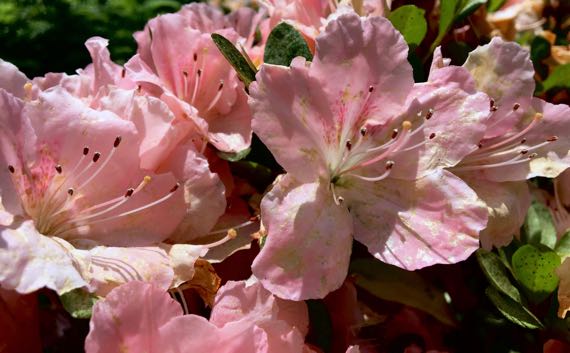
We’re finishing up the run of pale pink azaleas out front.
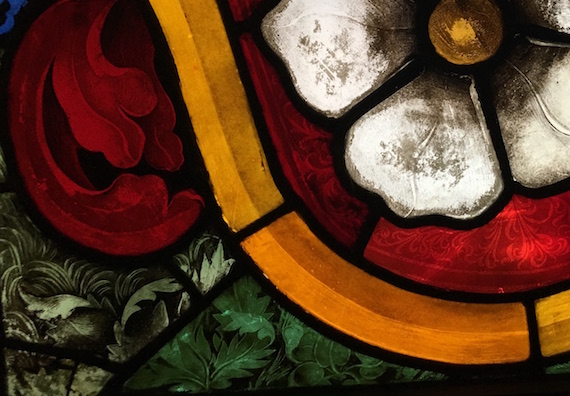
And…another “residual”…of a detail shot…from the Cluny, of a 1467 Mullenheim family arms stained glass piece. Love the shading, 3-D effects, color choices, whole ball of…not-wax.
Posted at 10:22 PM |
Comments Off on There goes April

One image I didn’t give you from our England visit is of a thatched-roofed building. This one is neither a remarkable structure nor unusual thatch. Seems like many of the still-thatched buildings are right next to the road, suggesting they are old country routes…. Quite a chimney on this one, no? Note, too, the use of dense hedges as visual barriers….
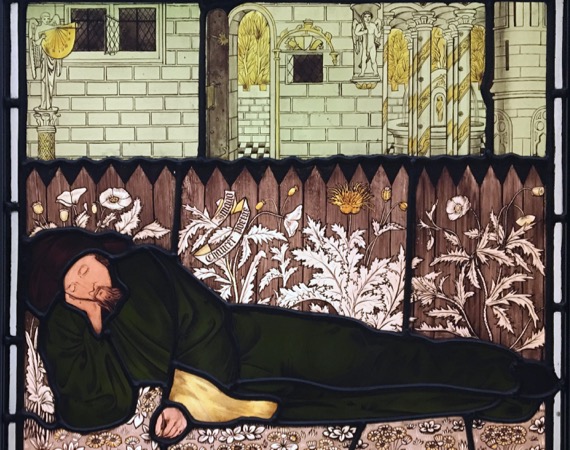
This is not church-glass, but ca. 1864 by a Neo-Gothic arts-and-crafts artist, a small piece we saw at the Musée National du Moyen Âge, titled “Chaucer asleep.” The designer was Sir Edward Coley Burne-Jones, and it was made by William Morris‘s decorative arts guild, which had six partners including Burne-Jones (photo of both men in 1874 here). They founded the group in 1861, and this piece was made just before their firm garnered a lot of business. In the 1850s, Burne-Jones was enamored of Canterbury Tales, so his choice of Chaucer before his design was in service of clients makes sense.
What I especially liked is all the plant-detail—in the meadow with the sleeping figure, against the fence, and glimpsed through openings in the wall. I like the angel holding the solar timepiece, left, and the poppies(?) by the fence. Interesting that the cloak is green, but not the plants…. I also like that his foot pokes gently out of what is otherwise the boundary of the rectangular piece, and into the framing area. BTW, the words are “Imago Chaucer Poetae.”
Posted at 10:22 PM |
1 Comment »

Somehow I associate both wild and Victorian with columbines…and it seems I’m pretty ignorant of their botanical history.
Having trouble adjusting to temps with highs well into the 80s. Still cools off at night, thankfully….
Posted at 9:53 PM |
Comments Off on A pollen producer
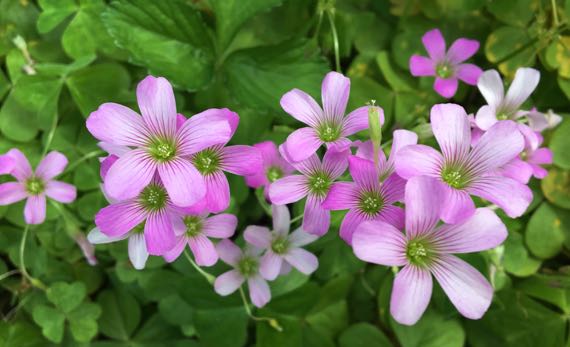
We’re home, so, hmmm, fleurs?
Posted at 9:52 PM |
Comments Off on Yawn. What time is it?
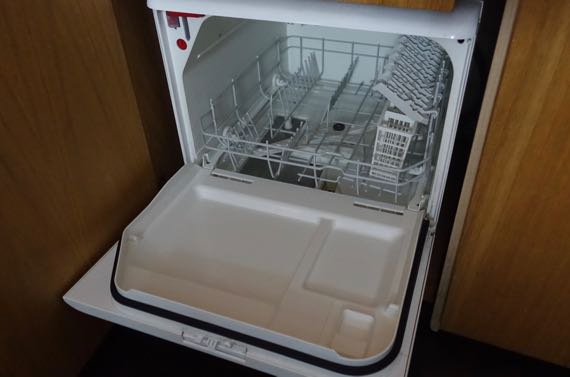
This is the smallest dishwasher I remember seeing (largest interior dimension maybe 1ft). We did not use it.

I learned another new French word: Bronzage. It does not mean Bronze Age, but bronzed/bronzing, as in changing the color of your skin (as in tanning place).

We took the bus and not the train to the airport, which we had not done before. Thus, we saw neighborhoods we’d only tunneled beneath before. Gambling anyone?

We had a pretty darned good view of Paris as we climbed away from the earth. That’s the Eiffel Tower “above” and back from the oblique white “doughnut” stadium in the right half of the photo. You can see the Seine next to it….

Wonder of wonders, the flight was not full (not at all), and the flight attendants were a bit giddy (or maybe not), offering two bottles of bourbon when I asked for liquor. Why not?
We are home safely and all is well. What’s next, you may ask…laundry, I’d say, being prosaic…but not until tomorrow….
Posted at 9:16 PM |
1 Comment »
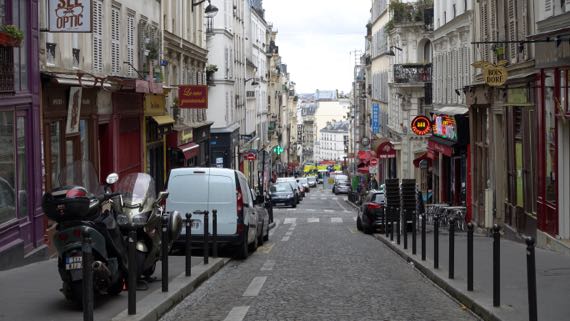
Once completely coffee-d, we headed uphill on foot. Uphill from here means north and toward Montmartre. The buildings obscured the tall dome of Sacré-Cœur until we were half-way there (horizontally—we’d already gained maybe ten flights). Here’s looking back along a side street off Pigalle.
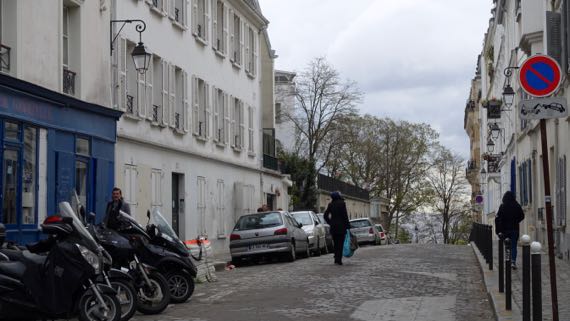
Farther uphill; look how the road heads toward airborne obscurity.
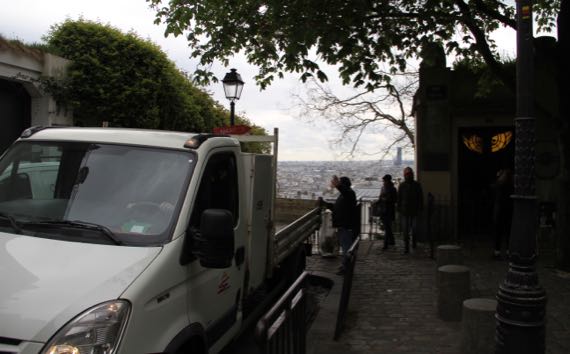
Now we’re up so high the roofs and walls below are mosaic of greyish shapes.

We wound through the Place—should be the Place des peintres et des taxis. We avoided the taxis and bought no art en route to the small church up here, Église Saint-Pierre de Montmartre. This church is the oldest in Paris, and is said to be atop the ruins of a Roman temple to Mars—hence the name Montmartre, now corrupted to refer to a martyrdom. The church pertained to a Benedictine abbey—long gone. I loved the glittery stars and other shapes between the paving stones in front of the church.
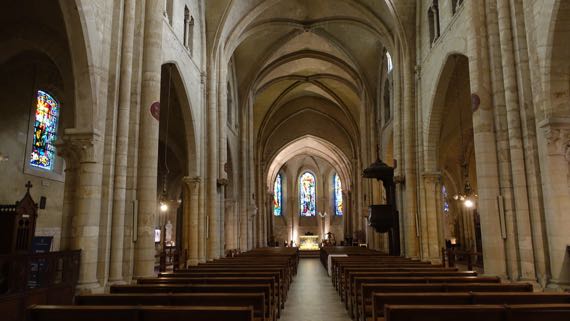
It’s a modest church, with the usual accouterments. For the big candles, with glass surrounds and images of the Madonna, the requested donation was €10…for simple tea lights it was €3. Pricey up here closer to the deity.
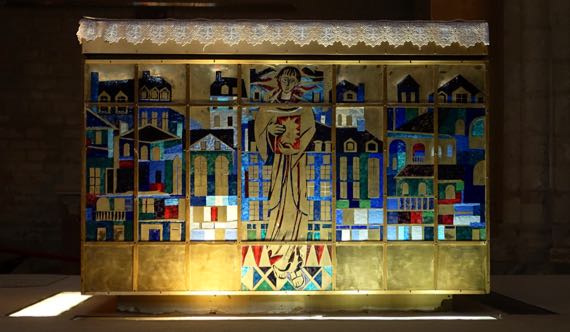
Illustration in glass and metal on one side of the chunky altar.

Side chapel ceiling and upper walls.
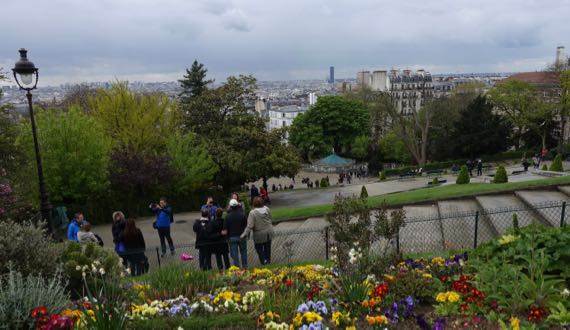
Yes, we did wind around to prepare to descend the front garden-and-staircases…whatta view!
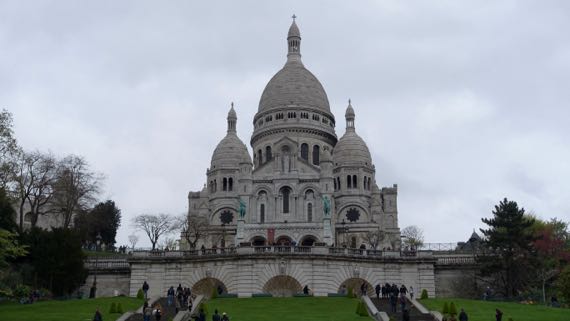
And look back up at Sacré-Cœur. Iconic.
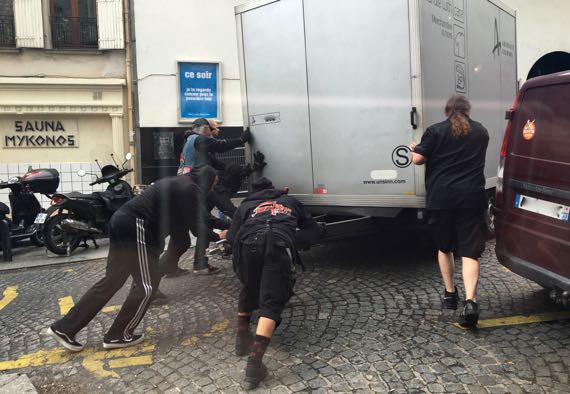
Down the way, loving the descent, we stopped to eat in a simple brasserie at about the same elevation as the Moulin Rouge. Our table was in the window, and we watched pedestrians, the usual. Then these roadies pushed this heavy trailer uphill (the truck that brought it and other gear was parked below, around the corner and out of sight) and jockeyed it into a parking spot (or what became a parking spot) in front of the venue. They earned their wages for the unloading and man-handling; there were at least seven of them pushing—it was heavy and gravity was not in their favor.

On a lark, we headed out northeast, but still well within metro Paris, to a design school to see a free exhibition. The billing was that it was recent student work. I saw dates like 2005 and 2010 and 2008, so maybe not so recent after all…although these forms were kinda cute.
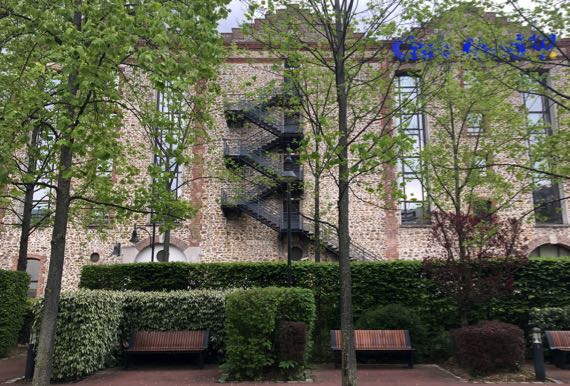
Around the corner but still in the complex, we found a park to sit in and gather our thoughts. I felt compelled by this emergency staircase, black metal against a stone wall…the building housing a Club Med, no lie.
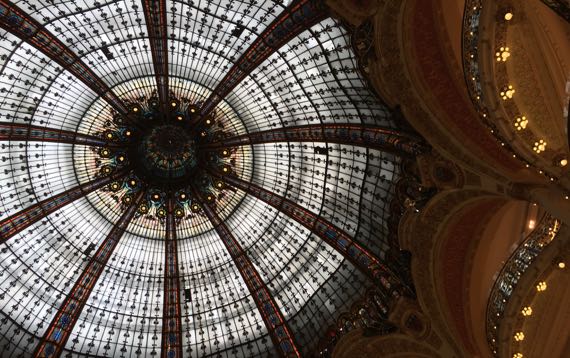
Back in our neighborhood, we’ve been walking around the Galleries Lafayette Haussmann. Apparently there are other Galleries Lafayette. This one is the flagship; it was darned busy, and especially caters to Chinese shoppers. The dome is an elegant show stopper, with tier after tier of balconies leading the eye to the dome-center (completed in 1912). We only wound our way through the choked aisles of the basement and main floor…trying to escape.
Posted at 11:36 AM |
Comments Off on Ups and downs, with laterals

We collected by far the most images at the Cluny. Or, many call it the Cluny, but the name is actually Musée National du Moyen Âge—Thermes et hôtel de Cluny. Cluny was a Benedictine abbey 225mi SSE of Paris, near Mâcon, and this was their “townhouse” in Paris (begun in the 1300s and rebuilt around 1500). It was built atop Roman baths, hence the second part of of the name…. The first part refers to the Middle Ages, which is the temporal focus of the collection. The nearest subway station honors the arts with tile versions of artists signatures on the ceiling.

Euros are being spent on revamping parts of the complex, and the entrance currently is through a narrow portal into a non-symmetrical quadrilateral courtyard (with a security tent…open your handbag, ma’am, please (only in French)).

Many stone walls of the abbey are…very clean, no stucco, no paint. Stairwells and so on have been added to make the buildings into a museum.
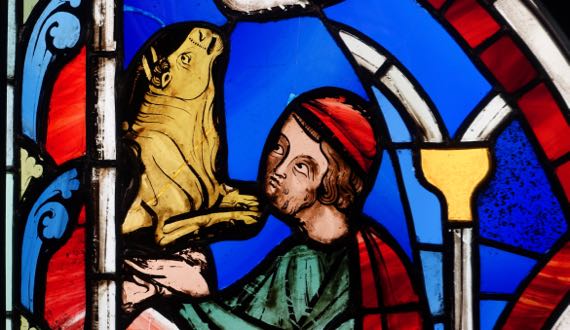
We didn’t make it into the Sainte-Chapelle (near Notre-Dame), but we did get to see about two dozen small window panels from it…very close up. Love the detail on this bull and man’s face.

Also on this murderous knight and his non-plussed horse.
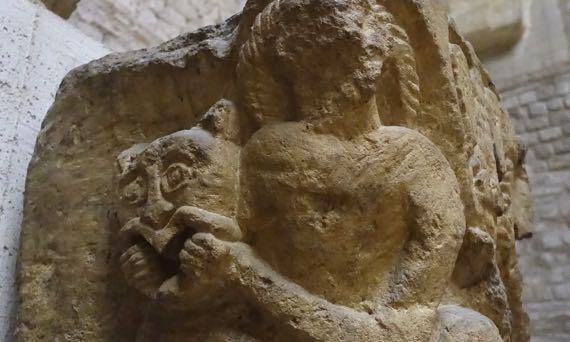
This is detail from a capital from the church in the abbey complex of Saint-Germain-des-Prés (Paris), showing Daniel tangling with the lion. This abbey was founded in the 500s, and this stonework dates to 1030–1040. Through the Middle Ages, the abbey owned quite a chunk of land on the West Bank.

The Cluny collection may be best known for the La Dame à la licorne/the lady and the unicorn tapestries. There are six, with five obviously pertaining to the senses—smell, touch, taste, hearing, and sight. The sixth has the words À mon seul désir…what the soul desires, so is a bit enigmatic—maybe love, joie de vivre, something along those lines. This is a detail from the sight one, with the lady holding a mirror for the unicorn to see its reflection. The tapestries are huge.
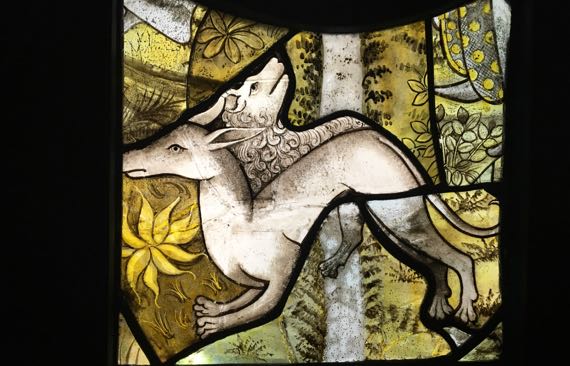
Stained glass detail (I/we did not record the source).

1490–1493 Book of Hours devotional by Antoine Vérard, who was first to combine printed black text with hand-drafted colored “capital” letters, thereby combining the best of the new printing process with the artistic elegance of the old by-hand-only methods.
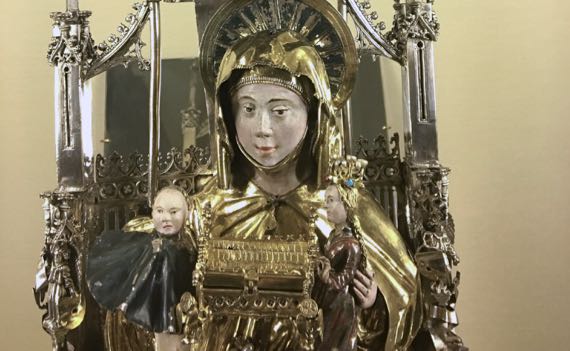
This is a detail of a reliquary of St Anne, and she is holding a mini-reliquary. That does make the point, doesn’t it?
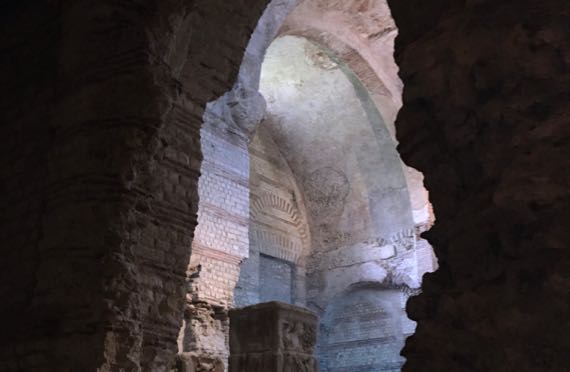
The chapel of the Cluny monastery complex is stripped of its decorations and has only a few museum pieces in it. The emptiness and bare walls are striking. Footsteps echo loudly.
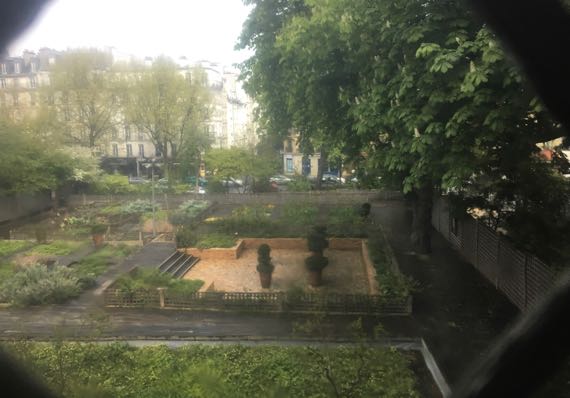
From an upper level I could see into the garden. We were only able to enter a small portion that did not include this part.

From the street, here is Cluny ruins atop thermae ruins (I think).
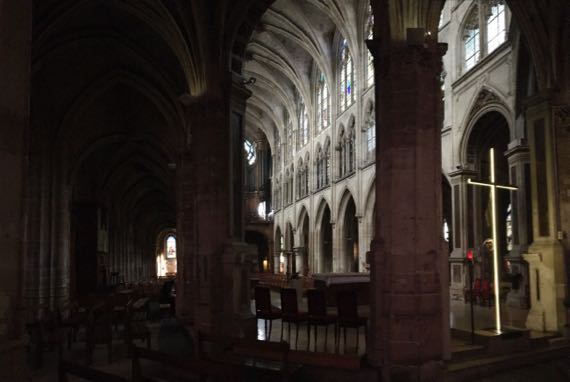
Somehow we made it into another church, the Église Saint-Séverin. Séverin apparently was a hermit in Paris’s early Christian times. Behind the altar (and behind me for this photo) are six large stained glass windows dating to 1970, with modernist (not realist) color panels that we both liked.

And one more church…near where we’re staying…the Église Saint-Louis-d’Antin. It began as a Capuchin establishment about 1775. Most of the rest of the complex became a lycée in 1883.
What a Sunday.
Posted at 3:22 PM |
Comments Off on Sunday best

Meet Marianne. She’s the personification of the Republic of France, and the visual anchor of Paris’s Place de la République. In particular, she represents the dissolution of the monarchy and the installation of the republic. Power to the people (more or less). A female figure representing liberty goes back to the later 1700s, and became a widely used icon with the 1789 storming of the Bastille, a prison and symbol of royal authority in central Paris.
This is not far from the neighborhood of the blown-up nightclub, etc., and it has been and continues to be a place of political statements and demonstrations.
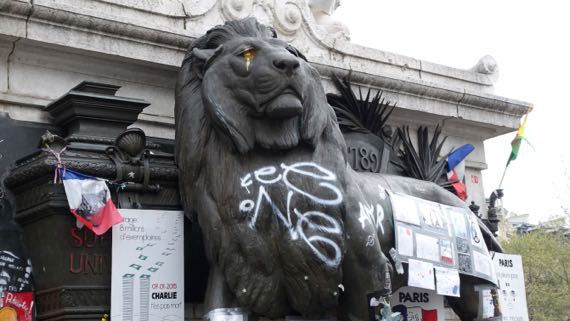
Below Marianne and still above eye level is an oversized lion guarding a ballot-box. More République. Today he had golden tears.

And, on the surface at knee level, many candles and living and plastic/fabric flowers and plants. The topics addressed in word and picture range around the world.
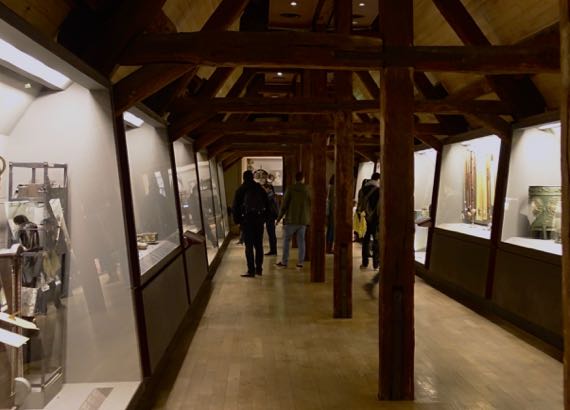
We chose the Musée des Arts et Métiers for today’s brain teaser. It is a museum of industrial design including models of large, complex things (steel furnace), and smaller complicated mechanical items (measuring devices). They sent us to the attic to work our way through the galleries and descend…. Loved the open beams there….

1713 double horizontal sundial.

1825 clock, close-up of upper section.

Bobbins on a mechanical weaving machine.
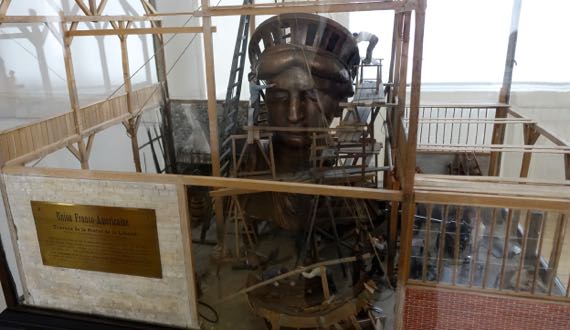
Detailed diorama of the building of the Statue of Liberty in New York harbor.
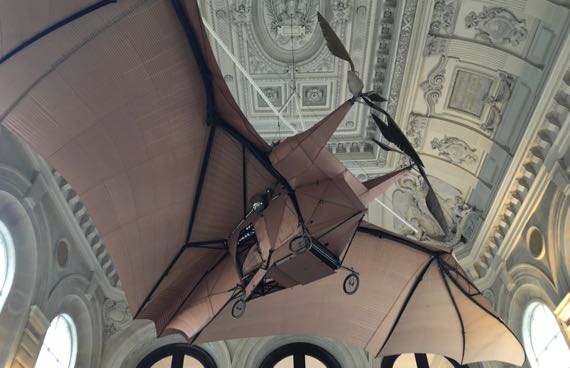
We descended a final staircase, very fancy, marble, wide, and highly decorated. Above us, curators have installed Clément Ader’s Avion/Éole III (1897), with the form modeled on a bat, with feather-shaped propellors. It crashed on its first attempt at flight, and was restored in the 1980s. It does look rather like a modular bat.
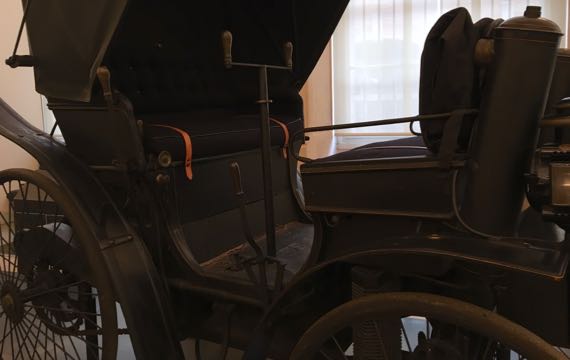
Through a hallway of transportation (this is a Peugeot), we headed for the Chapel of Saint-Martin-des-Champs, a part of what once was the second-most important priory in France, and now within the museum complex. Most of the complex was removed during the Revolution.
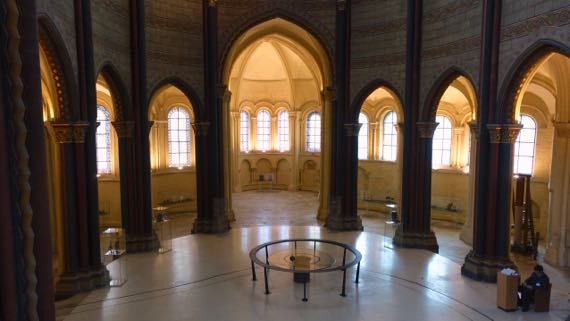
The “front” of the church is empty, very interesting, with a pendulum slowly moving, showing the earth’s revolutions.
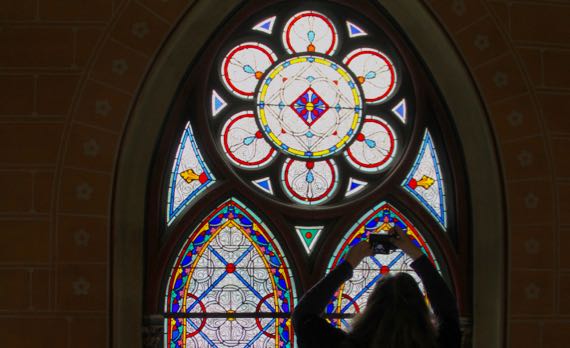
The bulk of the church-space has exhibits, which include a small engineering wonder—stairs and glass exhibit-floors extending four stories (or so) up. While I had some trepidation about the height, I was glad to get so close to the stained glass panels.
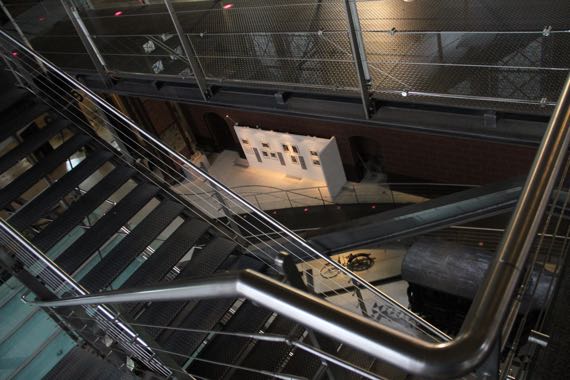
This museum—industrial design from start to finish….
Posted at 12:00 PM |
Comments Off on Industrial design + old church
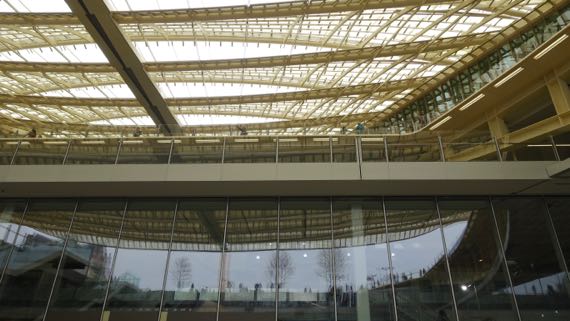
First stop (after coffee): the new Les Halles. Once the site of Paris’s huge fresh food market, it’s been a shopping mall for decades, and was refurbished last year, with this remarkable swooping roof. A new garden outdoors is only partly open.
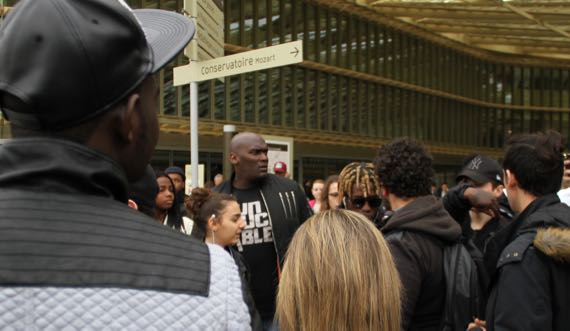
In the moving crowds, we spotted this clot that wasn’t moving. Autograph- and selfie-seekers. The tall guy is security. The ombre-dreads fellow is the celebrity. We didn’t recognize him. Musician, as he was signing CDs….
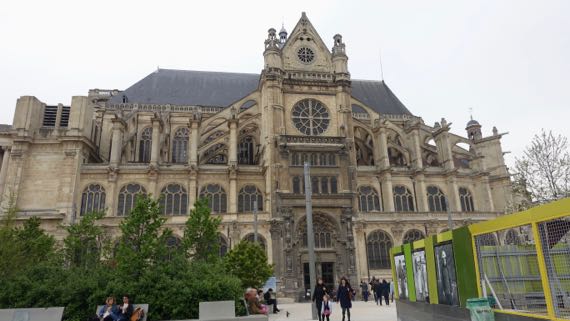
Also facing the Les Halles area, this old church, Saint-Eustache, built between 1532 and 1632, although there was a parish church here by 1223. Contrasting centuries and architectural styles….
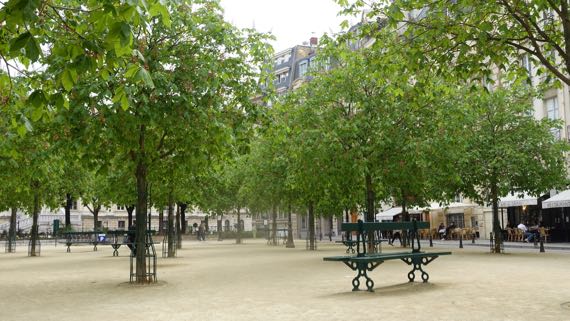
We kept moving, crossing onto the Seine’s western isle. We enjoyed a few minutes on a sturdy bench among the leafing-out chestnuts, preparing ourselves for things to come.

Of course, next was Notre Dame, and this is the view I always remember, perhaps because it was the angle I first saw it…and realized that the façade is so truncated without the steeples.
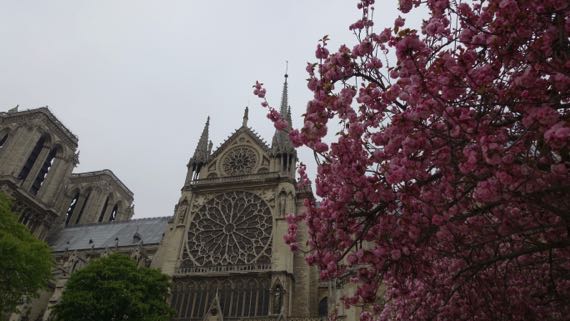
Over several significant construction periods, expansions and refurbishments, the building is what we see today. I remember most the façade, this rose window, and…
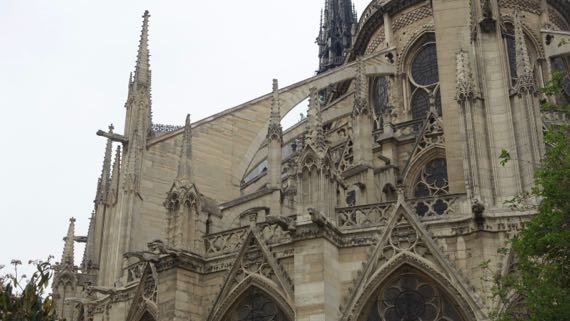
…the flying buttresses.

Nearby, without an extensive plaza facing and highlighting the building is the 13th-C Sainte-Chapelle, the royal chapel known for its beautiful glass windows. Which I have heard about and not seen—45-minute wait on a cloudy day…we passed. Next time, we vowed….
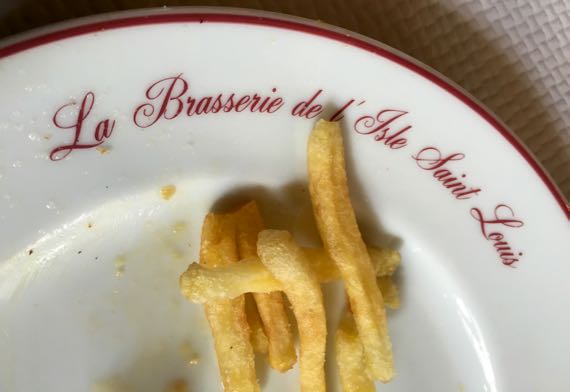
Also, we were hungry. So we strolled down to the eastern isle and a brasserie we first visited in 1989. Simple Parisian food, well made.
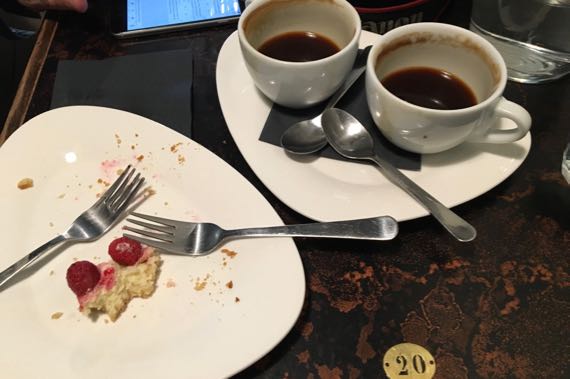
Then, heading toward a subway stop, we saw a coffee shop we enjoyed on our last visit. With pastries. Yum, raspberry cheesecake-tart.

Many of the parked motorcycles have these blankets; I remember fewer in Rome. A warmer, drier way to ride….
Posted at 10:22 PM |
Comments Off on Core Paris

The great switch day began with packing up. Despite how small our Ikea-sized room was, I kept finding little stashes of belongings that needed to be en-luggaged.
Eventually, we made our way to the BritLibrary Sbux, and gained functioning brain cells by astute application of caffeine and internet-time.

Then, a short roll to St Pancras for our pending international departure…. Soon, we were rolling at fast-train speeds. Overcast for our entry into France. Spring seems more sprung here.

We had dressed for morning-London temps, and arrived in afternoon Paris-warmth, so adjourned to fast showers before heading out to an auberge (really a restaurant) that seemed well-reviewed on the web. We liked the posted menu and the street-appeal and strolled in. Tables available—yippee! This was our dessert, a house specialty, a trio of shuffles, each with a matching sauce/liquid added—chocolate (of course), caramel (out of this world buttery sauce), and Grand Marnier.
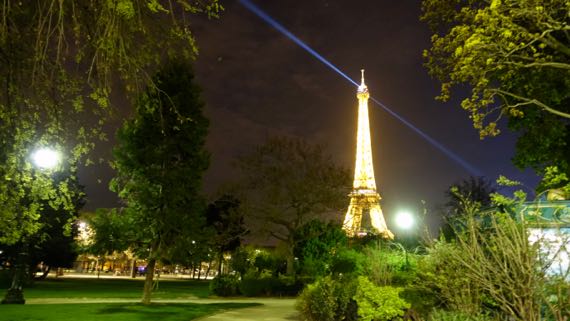
Our after-dinner stroll was to, where else…. Don’t remember the blue spotlights. Look how leafed out the trees are here….
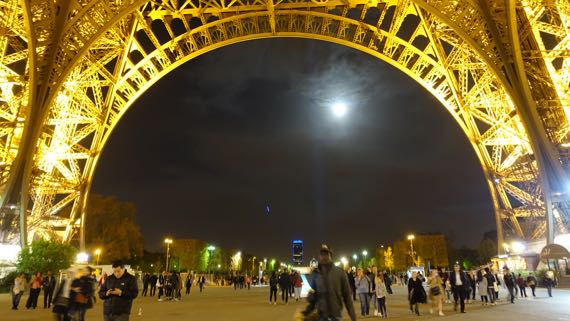
And looking back from the river, there’s the moon. Can you say romantic?
Posted at 10:22 PM |
Comments Off on London ➙ Paris



































































